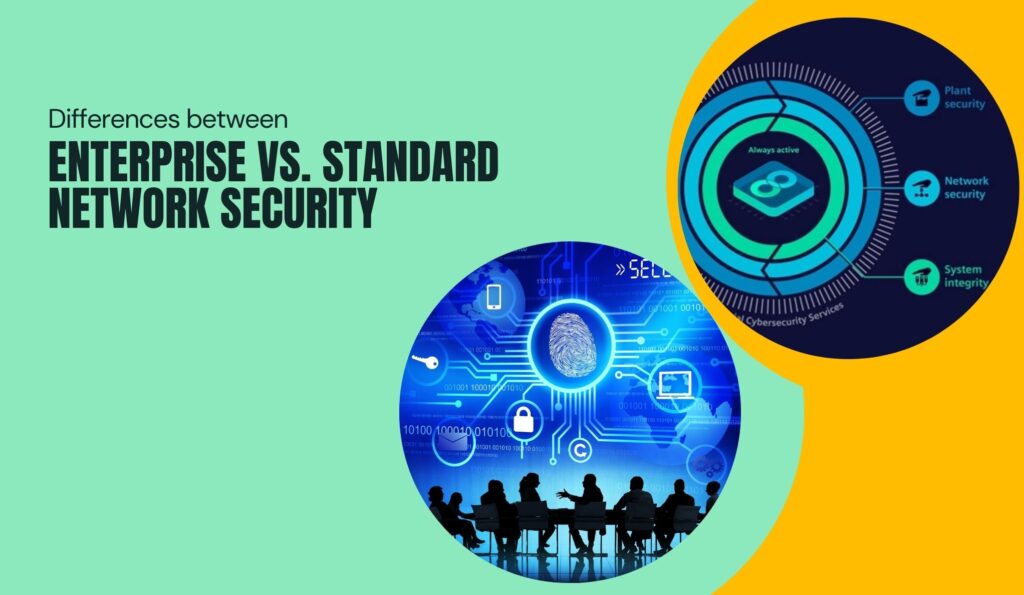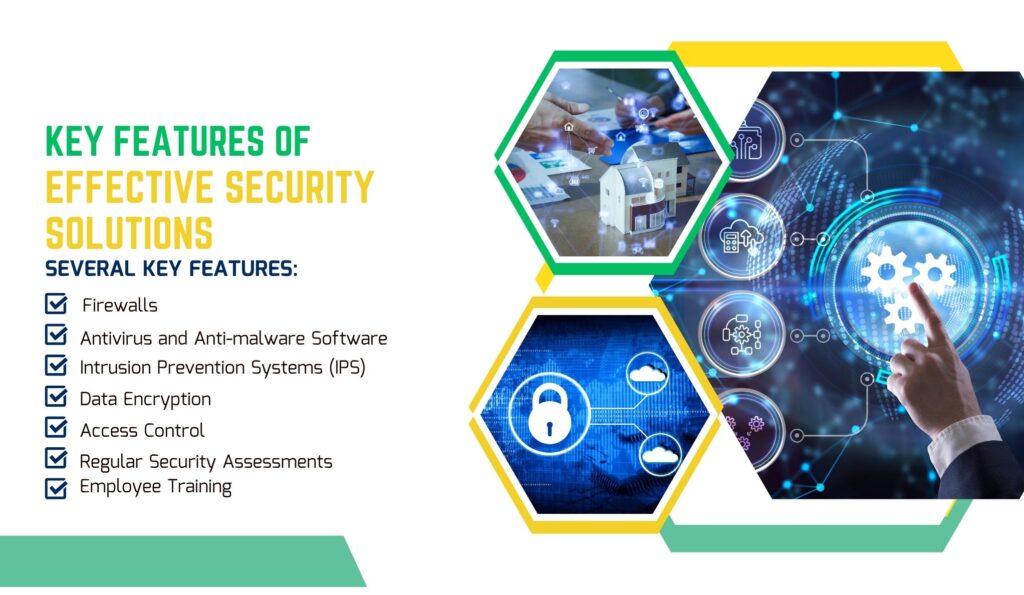In the digital era, network security has become a cornerstone for the success and safety of enterprises. As cyber threats evolve, understanding and implementing robust network security strategies is more crucial than ever. This article aims to shed light on the critical aspects of enterprise network security, offering insights into the strategies, tools, and practices essential for protecting business networks.
The Critical Role of Network Security in Modern Enterprises
Network security in enterprises is not just a technical requirement; it’s a vital defense mechanism against data breaches and cyber attacks. The increasing incidents of cyber threats highlight the need for stringent security measures. Effective network security safeguards sensitive data, ensures business continuity, and maintains customer trust, forming the backbone of a secure and resilient digital enterprise.
Overview of the Article’s Scope and Purpose
This article serves as a comprehensive guide, focusing on the nuances of enterprise network security. It delves into various strategies, from basic definitions and common threats to advanced technological tools and management practices. The goal is to equip businesses with the knowledge and tools to fortify their network security effectively, aligning with the latest trends and challenges in the cyber world.
What is Enterprise Network Security?
Enterprise network security is a vital aspect of modern business operations, involving a range of practices and technologies to protect an organization’s network and data from breaches, attacks, and unauthorized access. It encompasses measures to secure both internal and external network connections, ensuring the integrity, confidentiality, and availability of data. This section outlines the fundamental aspects of enterprise network security and how it differs from standard network security.
Defining Enterprise Network Security
Enterprise network security refers to the strategies and tools employed by businesses to protect their networks against cyber threats and vulnerabilities. It includes a variety of components such as firewalls, antivirus software, intrusion detection systems, and encryption protocols. These measures are designed to monitor and prevent unauthorized access, misuse, or modifications of the network and its resources. Effective enterprise network security is a dynamic process that involves continuous assessment and updating to address emerging threats and technologies.
Differences between Enterprise and Standard Network Security

While both enterprise and standard network security share the common goal of protecting networks from cyber threats, they differ significantly in scale, complexity, and scope. Enterprise network security is typically more complex due to the size and diversity of organizational networks, encompassing a wider variety of devices and connections. It often requires more sophisticated and robust security measures to address the unique challenges and higher stakes involved in protecting sensitive corporate data and large-scale infrastructures. In contrast, standard network security, often used in smaller businesses or individual setups, deals with simpler network structures and faces relatively lower-risk scenarios.
Common Threats to Enterprise Networks
In today’s digital landscape, enterprise networks face a myriad of security threats that can compromise the integrity, confidentiality, and availability of corporate data. Understanding these threats is the first step in developing effective security strategies. This section provides an overview of the prevalent security threats and challenges, along with real-world examples of recent security breaches, highlighting the importance of robust network security measures.
Overview of Prevalent Security Threats and Challenges
Enterprise networks are particularly vulnerable to a variety of cyber threats, including:
- Malware Attacks: These include viruses, worms, and Trojan horses that can disrupt operations or steal sensitive information.
- Phishing Attacks: Cybercriminals use deceptive emails and websites to extract confidential information from unsuspecting employees.
- Ransomware: This involves attackers encrypting an organization’s data and demanding a ransom for its release.
- Distributed Denial-of-Service (DDoS) Attacks: These attacks overload the network with excessive traffic, rendering it inoperable.
- Insider Threats: Sometimes, the threat comes from within the organization, either intentionally or through negligence.
- Advanced Persistent Threats (APTs): These are prolonged, targeted attacks where hackers infiltrate networks to steal data over time.
Staying informed about these common threats is crucial for enterprises to develop effective countermeasures.
Case Examples of Recent Security Breaches
Recent high-profile security breaches illustrate the devastating impact of network attacks on enterprises:
- XYZ Corporation Ransomware Attack: In this case, attackers encrypted critical data of XYZ Corporation, demanding a significant ransom. The breach halted operations for days and led to substantial financial losses.
- ABC Healthcare Phishing Incident: Here, cybercriminals used phishing emails to gain access to patient records at ABC Healthcare, compromising personal and sensitive information.
- 123 Tech Insider Threat: An employee at 123 Tech inadvertently leaked sensitive intellectual property by falling victim to a phishing scam, demonstrating the risks posed by insider threats.
Essential Components of Network Security Solutions
Implementing effective network security solutions is crucial for safeguarding enterprise networks from various cyber threats. This section focuses on the key components that constitute a robust network security solution, and the vital role advanced software plays in enhancing network protection.
Key Features of Effective Security Solutions
Effective network security solutions typically comprise several key features that work together to protect enterprise networks:

- Firewalls: Serve as the first line of defense, controlling incoming and outgoing network traffic based on predetermined security rules.
- Antivirus and Anti-malware Software: Detects, prevents, and removes malicious software.
- Intrusion Prevention Systems (IPS): Monitors network activities for malicious incidents and can respond to detected threats.
- Data Encryption: Protects sensitive information by encoding it, making it inaccessible to unauthorized users.
- Access Control: Ensures only authorized personnel can access network resources.
- Regular Security Assessments: Involves evaluating the network for vulnerabilities and potential threats.
- Employee Training: Equips staff with knowledge about cyber threats and best practices for prevention.
These components form a comprehensive approach to network security, addressing various aspects of cyber protection.
Role of Advanced Software in Network Protection
Advanced software plays a pivotal role in enhancing the effectiveness of network security solutions:
- Automated Threat Detection: Utilizes machine learning and artificial intelligence to identify and respond to threats more quickly and accurately than manual methods.
- Security Information and Event Management (SIEM): Offers real-time analysis of security alerts generated by network hardware and applications.
- Cloud Security: Provides specialized solutions for protecting data and applications in cloud environments.
- Endpoint Security: Secures endpoints like computers and mobile devices from cyber threats, particularly important in remote working scenarios.
- Zero Trust Security Models: Assumes no user or device is trustworthy until proven otherwise, significantly reducing the risk of internal threats.
Strategies for Enhancing Network Security
To effectively counter the evolving landscape of cyber threats, enterprises must adopt strategic approaches to enhance their network security. This section outlines the best practices in enterprise network security management and emphasizes the importance of a proactive security approach, both of which are crucial for safeguarding an organization’s digital assets.
Best Practices in Enterprise Network Security Management
Effective management of network security involves a blend of technological solutions and strategic practices. Key best practices include:
- Regular Software Updates and Patch Management: Keep all software, including security tools, up-to-date to protect against known vulnerabilities.
- Strong Password Policies and Multi-Factor Authentication (MFA): Implement robust password guidelines and use MFA for an additional layer of security.
- Regular Data Backups: Ensure data is backed up regularly to prevent loss in case of a cyber attack.
- Network Segmentation: Divide the network into segments to contain breaches in isolated areas, preventing them from spreading.
- Incident Response Planning: Develop and regularly update an incident response plan to ensure quick and effective action in case of a security breach.
- Continuous Monitoring: Implement continuous monitoring of network activities to detect and respond to unusual activities promptly.
By adhering to these best practices, enterprises can significantly enhance the security and resilience of their networks.
The Importance of a Proactive Security Approach
A proactive security approach is essential in the rapidly evolving world of cyber threats. This involves:
- Anticipating Potential Threats: Stay informed about the latest cyber threats and anticipate potential risks to the network.
- Regular Security Audits: Conduct comprehensive audits to assess the effectiveness of current security measures and identify areas for improvement.
- Employee Education and Awareness: Regularly educate employees about cyber threats and security best practices, as human error is a common vulnerability.
- Investing in Advanced Security Technologies: Allocate resources for advanced security technologies that offer better protection against sophisticated cyber attacks.
The Role of Technology in Securing Networks
The advancement of technology plays a pivotal role in enhancing the security of enterprise networks. This section discusses how leveraging AI and machine learning for threat detection and staying updated with the latest tech trends are critical components in the realm of network security.
Leveraging AI and Machine Learning for Threat Detection
Artificial Intelligence (AI) and machine learning have revolutionized the field of network security by offering advanced capabilities in threat detection and response. These technologies enable:
- Automated Threat Detection: AI algorithms can analyze patterns and detect anomalies in network traffic, identifying potential threats faster and more accurately than traditional methods.
- Predictive Analysis: Machine learning can predict potential security incidents by analyzing trends and patterns in data.
- Adaptive Response Mechanisms: AI-driven systems can adapt and respond to new and evolving cyber threats, continually updating their defense mechanisms.
Incorporating AI and machine learning into network security strategies significantly enhances an organization’s ability to detect and mitigate cyber threats efficiently.
Importance of Staying Updated with the Latest Tech Trends
Staying vigilant in network security entails three key steps. First, regularly update software and systems with the latest patches and versions. Second, embrace emerging technologies such as blockchain, cloud security solutions, and advanced encryption methods. Finally, engage with online security communities and forums to stay informed about evolving threats and innovative solutions. These practices ensure robust network security in today’s dynamic technological landscape.
Developing a Robust Security Policy
A robust security policy is the backbone of effective enterprise network security. It outlines the standards, procedures, and practices that govern the use and protection of the organization’s network and information systems. This section focuses on crafting tailored policies for different enterprise sizes and types and the significance of employee training and awareness programs.
Crafting Policies for Different Enterprise Sizes and Types
The creation of a network security policy should consider the specific needs and characteristics of the enterprise. For this:
- Small and Medium-sized Enterprises (SMEs): Policies should focus on core security practices that are feasible and effective for smaller networks, such as regular software updates, basic access controls, and employee cybersecurity training.
- Large Enterprises and Corporations: Security policies in larger organizations need to address more complex network structures, integrating advanced security technologies, detailed incident response strategies, and comprehensive data protection measures.
- Industry-Specific Requirements: Enterprises in certain industries, like finance or healthcare, may require specialized security policies to comply with industry-specific regulations and protect sensitive data.
Tailoring security policies to the size and type of the enterprise ensures that the network security measures are both practical and effective.
Employee Training and Awareness Programs
Employee education is a critical aspect of network security. Effective training and awareness programs should:
- Educate on Basic Security Practices: Teach employees about strong password creation, identifying phishing emails, and safe internet usage.
- Regular Updates on Emerging Threats: Keep the workforce informed about the latest cyber threats and scams.
- Simulated Cybersecurity Exercises: Conduct mock drills or simulations to help employees understand how to respond during actual security incidents.
- Promoting a Culture of Security: Encourage a workplace culture where security is everyone’s responsibility, and employees feel empowered to report suspicious activities.
Network Security Management: Best Practices
Effective management of network security is a continuous process that requires vigilance and adaptation. This section highlights the best practices in network security management, focusing on continuous monitoring and regular updates, as well as the implementation of multi-layered security strategies. These practices are vital for maintaining the integrity and resilience of enterprise networks against evolving cyber threats.
Continuous Monitoring and Regular Updates
Continuous monitoring and the regular updating of security systems are crucial for effective network security management:
- Continuous Monitoring: This involves the ongoing observation of network activities to detect and respond to potential threats in real time. Utilizing automated tools and systems, such as intrusion detection systems and network traffic analysis, is essential for this process.
- Regular Updates: Keeping all network security software and hardware up to date is critical. This includes regularly updating firewalls, antivirus programs, and other security tools with the latest patches and definitions to protect against new vulnerabilities and threats.
These practices help in identifying and mitigating security risks promptly, ensuring the network remains protected against the latest cyber threats.
Implementing Multi-Layered Security Strategies
Adopting a multi-layered approach to network security enhances the overall protection of enterprise systems:
- Defense in Depth: This strategy involves using multiple layers of defense at different points in the network. For example, combining firewalls, antivirus software, and intrusion detection systems provides multiple barriers against cyber threats.
- Segmentation of Networks: Dividing the network into separate segments or zones can contain breaches and prevent them from spreading across the entire network.
- Zero Trust Model: Implementing a zero trust security model, where every user and device is treated as a potential threat until verified, can significantly reduce the risk of insider threats and unauthorized access.
Conclusion
In the evolving landscape of cyber threats, the importance of robust enterprise network security cannot be overstated. This article has outlined the essentials of network security, addressing its definition, the unique challenges faced by enterprises, and the common threats that jeopardize network integrity. We have emphasized the criticality of adopting a multi-faceted approach, incorporating continuous monitoring, regular updates, and employee training into an overarching security strategy.
By leveraging advanced technologies like AI and machine learning, and maintaining vigilance through best practices, businesses can significantly enhance their defensive mechanisms. The ultimate goal is to create a secure, resilient digital environment that not only protects against current threats but is also prepared for future challenges. As the digital landscape continues to evolve, so must our strategies for safeguarding our most valuable digital assets.








